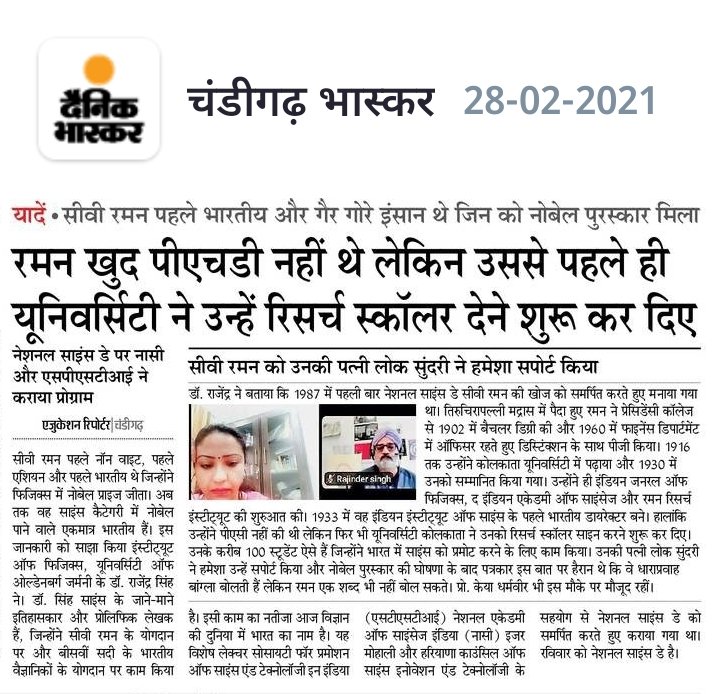An interesting presentation on “Vignettes from Raman’s Life” was made by Dr. Rajinder Singh from the Institute of Physics, University of Oldenburg, Germany. He is a well-known historian of Science and a prolific author who has made extensive studies on Raman’s contributions as well as early 20th century Indian scientists many of whom were responsible for the rise of current day scientific enterprise in India.
The Society for Promotion of Science & Technology in India (SPSTI), Chandigarh Chapter of National Academy of Sciences India (NASI), IISER, Mohali with support from Haryana Council for Science, Innovation & Technology celebrated the legacy of Raman to commemorate the national science day on Saturday, February 27, 2021 at 3.00 PM. The lecture was attended by students, teachers and members of the general public live from Zoom platform with more than 45 attendees, while many viewed it on the Facebook page of SPSTI. The proceedings started with opening remarks by Prof. Keya Dharmvir, General Secretary, SPSTI and Prof. Arun K. Grover, Former Vice Chancellor of Panjab University and Vice President of SPSTI steered it.
The webinar had two speakers. The second session was by Dr. Fourn Singh, Incharge, Structural & Spectroscopy Lab, Inter-University Accelerator Centre, New Delhi. He was introduced by Dr. Kiran Jeet from PAU Ludhiana, herself an expert in Raman spectroscopy. Dr. Singh demonstrated the Raman Spectrometer currently in use in his lab after introducing the basics of Raman scattering. He also discussed the multifarious ways in which Raman spectra are used to investigate properties of matter at the nano and molecular levels.
Dr. Rajinder Singh began his talk with the introduction of Indian National Science Day. The first National Science Day was celebrated in 1987, to commemorate the announcement of the phenomenon detected by Raman on 28 February, 1928. In 1930, C.V. Raman was the first non-white and the first Asian and the first Indian to win the Physics Nobel Prize. Till date, he remains India’s only Nobel Laureate in the field of Science (Chemistry, Physics, Medicine/Physiology). C. V. Raman was born in Tiruchirapalli, Madras and was the second of eight siblings. He was a child prodigy and studied at the Presidency College for his bachelors (1902) and masters (1907) degrees which he passed with highest distinction. He worked as a Govt. officer in the finance department, in Calcutta where he carried out after-office research at Indian Association for the Cultivation of Sciences from 1907-1916 and taught at Calcutta University and was awarded the Prize in 1930. He established the Indian Journal of Physics, the Indian Academy of Sciences and the Raman Research Institute. He joined the Indian Institute of Science in 1933 as its first Indian Director. Raman did not have a doctorate degree, yet the University of Calcutta started assigning research scholars under Raman at Indian Association for the Cultivation of Sciences. Raman was a great teacher and produced about 100 scientists who influenced the development of science in India. Ramn’s wife Lokasundari supported him throughout; after the Nobel announcement, journalists found to their amazement that she spoke fluent Bangla whereas Raman had picked up not a word of the language!
The sessions were followed with questions by students and science lovers. The session was much appreciated by attendees. Shri Dharam Vir, IAS (Retd.) & President SPSTI, presented concluding remarks and vote of thanks to the speakers, audience, organisers and Haryana Council for Science, Innovation & Technology.


